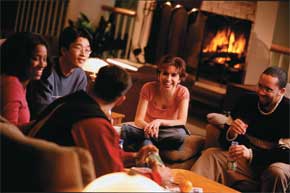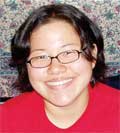
| First-year Experience Eases Adjustment to Block Plan | |
| by Julie Stockenberg and Anne Christensen Photo by Jason Jones |
| “ | Different as we are at Colorado College, we share one thing: the activity of learning. The First-year Experience uses the Block Plan to excite and intrigue first-year students about ideas, to focus their attention on vital skills, and to foster conversation inside and outside the classroom.” |

This excerpt from an FYE Steering Committee memo helped shape the First-year Experience program, which incorporates several elements: two linked one-block courses or a single two-block course taken at the beginning of the academic year, student mentors, and planned academic and social activities.
A high-minded idea, but does it work? “Right away, I got a feel for what the intensive Block Plan learning style was all about,” says Pete Fowler ’04. “Creative energy and critical thought crackled through the social atmosphere like blasts of electricity. The professors did a wonderful job at creating an intellectually stimulating environment, and the mentors seemed genuinely interested in my well-being as a new student.”
FYE courses are designed to inculcate CC standards for reading, research, and writing, and to establish the habit of using campus resources. FYE courses offered this fall include Utopia in Western Literature and Thought, Chinese language, Mathematical Explorations and Review of Calculus 1/2, and Physical and Environmental Geology.
Psychology Professor Kristi Erdal, who helped evaluate the FYE in 2003 after its first three years, says its most important aspect is the class size of 16 — even smaller than CC’s normal 25-student limit. “That makes it possible for us to give them more individual attention and feedback in their first college experience,” she says.
FYE classes also focus attention on the needs of new students. “You can keep first-year students academically ‘separated’ from upper-class persons very effectively to give them that extra guidance,” says Erdal. Former Dean Brenda Tooley, who helped get the FYE off the ground in 2000, notes initial trepidations about this aspect: “In creating special FYE classes, we knew there was some danger of isolating first-years from other students, or of ‘infantilizing’ students, but we’ve avoided that with student mentors.” Outside of classes, these older mentors help first-years transition to college, and specific initiatives create opportunities for interchange outside the classroom.
The 2003 evaluation showed “dramatic” increases in student usage of campus resources. FYE students made better use of the library by virtually any measuring stick: “gate count,” reference desk usage, circulation, enrollment in library use training. The FYE increases use of the Learning Center and has nearly doubled the use of the Writing Center.
Students speak highly of the FYE. Lacey Ramirez ’04 says, “My FYE was boot camp! It was extremely rigorous, but professors went out of their way to give positive feedback and to make me feel that I was truly capable of excelling at CC. And the intensity of the class caused us (the students) to bond quickly. The relationships that I established during this course with both professors and students endured for my entire four years at CC.”
Julie Stockenberg is director of first-year and sophomore studies and advising. Anne Christensen writes for the Bulletin.
New Student Orientation: Service Without Soapboxes
by Haruno Sengoku ’05
 At the beginning of my junior year, I cut my summer break short and came back to campus in time for New Student Orientation. In previous years, incoming first-year students participated in one day of service in town, but 2003 kick-started the longer, Southwest-oriented backpacking or community service trips in the Southwest funded by the college’sfirst Robert & Ruby Priddy Charitable Trust grant.
At the beginning of my junior year, I cut my summer break short and came back to campus in time for New Student Orientation. In previous years, incoming first-year students participated in one day of service in town, but 2003 kick-started the longer, Southwest-oriented backpacking or community service trips in the Southwest funded by the college’sfirst Robert & Ruby Priddy Charitable Trust grant.
My co-leaders Katie Cox ’06 and Jennifer Provizer ’04, nine wonderful first-year students, and I arrived in Santa Fe, N.M., on a surprisingly rainy afternoon. Since the church we were scheduled to stay in was in the middle of services, we occupied ourselves by going bowling — the perfect remedy for people who had just endured a seven-hour drive!
Our group bonded quickly, from our drive-time icebreakers to our rotating kitchen assignments, which helped us work well together for Santa Fe’s Habitat for Humanity organization. We spent three days installing insulation, hammering in a roof, and helping out with the wiring side-by-side with the owners of the house and Habitat’s amazing crew of dedicated volunteers. Between construction tasks, Jennifer and I toured a house we had worked on five months earlier on a different service trip. Looking at a house we helped finish, while starting a new one with the proud owners smiling at us, was so encouraging!
As leaders, we never stood on a soapbox to rant. Rather, we slipped in pieces of advice when asked or when it seemed appropriate. I had a rough first semester here at CC (wasn’t doing so well in classes, partied perhaps a bit too much), but then I got my act together. So I told them that although it’s a new and exciting experience, they shouldn’t ever forget why they are here. It became our inside joke: “Don’t mess up like Haruno did!” We also talked about academic departments and our majors, the professors we loved and those we didn’t like so much, and the student groups we were involved in.
After our workdays, we continued to get to know each other in the church kitchen making dinner, playing cops and robbers, becoming addicted to card games, chasing each other in a water balloon fight, walking around downtown, and konking out after watching horrible movies.
New Student Orientation service trips allow the incoming class to enjoy a few days off campus and get to know returning students. They also give us all a sense of purpose. In four days, we didn’t just tell these students about CC, we showed them what more than 84 percent of our students do on their own time — give back to the community. Experiences such as this one motivated me to complete five CC service trips, and I hope that future first-year students will have as much fun as I have had with these experiences.
Here's one of 35 facts about CC:
29
15 percent of CC students belong to one of three sororities or three fraternities.
The Colorado College | 14 East Cache La Poudre Street | Colo Sprgs, CO | 80903 | 719-389-6000